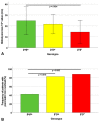Link between Genotype and Multi-Organ Iron and Complications in Children with Transfusion-Dependent Thalassemia
- PMID: 35330400
- PMCID: PMC8950605
- DOI: 10.3390/jpm12030400
Link between Genotype and Multi-Organ Iron and Complications in Children with Transfusion-Dependent Thalassemia
Abstract
We evaluated the impact of the genotype on hepatic, pancreatic and myocardial iron content, and on hepatic, cardiac and endocrine complications in children with transfusion-dependent β-thalassemia (β-TDT). We considered 68 β-TDT patients (11.98 ± 3.67 years, 51.5% females) consecutively enrolled in the Extension-Myocardial Iron Overload in Thalassemia network. Iron overload was quantified by T2* technique and biventricular function by cine images. Replacement myocardial fibrosis was evaluated by late gadolinium enhancement technique. Three groups of patients were identified: homozygous β+ (N = 19), compound heterozygous β0β+ (N = 24), and homozygous β0 (N = 25). The homozygous β0 group showed significantly lower global heart and pancreas T2* values than the homozygous β+ group. Compared to patients with homozygous β+ genotype, β0β+ as well as β0β0 patients were more likely to have pancreatic iron overload (odds ratio = 6.53 and 10.08, respectively). No difference was detected in biventricular function parameters and frequency of replacement fibrosis. No patient had cirrhosis/fibrosis, diabetes or heart failure, and the frequency of endocrinopathies was comparable among the groups. In pediatric β-TDT patients, there is an association between genotype and cardiac and pancreatic iron overload. The knowledge of patients' genotype can be valuable in predicting some patients' phenotypic features and in helping the clinical management of β-TDT patients.
Keywords: complications; genotype; iron overload; transfusion-dependent thalassemia.
Conflict of interest statement
The authors declare no conflict of interest.
Figures


References
-
- Thein S.L. Genetic modifiers of beta-thalassemia. Haematologica. 2005;90:649–660. - PubMed
-
- Cappellini M.D., Cohen A., Porter J., Taher A., Viprakasit V. Guidelines for the Management of Transfusion Dependent Thalassaemia (TDT) 3rd ed. Thalassaemia International Federation; Nicosia, Cyprus: 2014. - PubMed
Grants and funding
LinkOut - more resources
Full Text Sources

